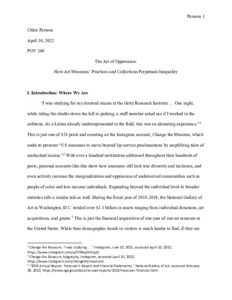| dc.rights.license | In Copyright | en_US |
| dc.creator | Parsons, Chloe R. | |
| dc.date.accessioned | 2022-04-21T13:03:22Z | |
| dc.date.available | 2022-04-21T13:03:22Z | |
| dc.date.created | 2022 | |
| dc.identifier | WLURG38_Parsons_POV_2022 | |
| dc.identifier.uri | http://hdl.handle.net/11021/35839 | |
| dc.description | Chloe R. Parsons is a member of the Class of 2022 of Washington and Lee University. | en_US |
| dc.description | Capstone; [FULL-TEXT RESTRICTED TO WASHINGTON AND LEE UNIVERSITY LOGIN] | en_US |
| dc.description.abstract | Since positive museum representations within audiences and art further the development of capabilities of play, affiliation, and senses, imagination, and thought, it is not only important to include marginalized communities in these cultural spaces, but it is an ethical duty. When examined through lenses of utilitarianism and contractualism, it becomes apparent that it is important to cultivate these capabilities by increasing representation of marginalized groups in museum boards, staff, programming, and collections or exhibits. Utilitarianism is a moral theory that suggests the most ethical course of action is one that produces the most good for the most people, and contractualism is a moral theory that says the most ethical course of action is one whose principles cannot be reasonably rejected by any party. (50) These moral theories are an important part in our discussion because they help provide a framework to decide what is morally correct and important, as well as how one may respond to any counterarguments against the prescribed course of action. Utilitarianism and contractualism are particularly important because they are two of the most prevalent moral theories and often have opposing strategies to get to their moral rights, so if they converge on a prescribed course of action, then it further supports the ethical importance of such actions. Diversifying collections and exhibits, expanding programming types and topics, and effectively marketing these developments towards such communities may increase museum-going as racial minority and lower-income groups often cite supporting community events and celebrating their cultural heritage as a major reason they visit arts-centric spaces. (51) [From Ethical Analysis and Recommendations section] | en_US |
| dc.format.extent | 34 pages | en_US |
| dc.language.iso | en_US | en_US |
| dc.rights | This material is made available for use in research, teaching, and private study, pursuant to U.S. Copyright law. The user assumes full responsibility for any use of the materials, including but not limited to, infringement of copyright and publication rights of reproduced materials. Any materials used should be fully credited with the source. | en_US |
| dc.rights.uri | http://rightsstatements.org/vocab/InC/1.0/ | en_US |
| dc.subject.other | Washington and Lee University, Shepherd Poverty Program | en_US |
| dc.title | The Art of Oppression: How Art Museums' Practices and Collections Perpetuate Inequality | en_US |
| dc.type | Text | en_US |
| dcterms.isPartOf | RG38 - Student Papers | |
| dc.rights.holder | Parsons, Chloe R. | |
| dc.subject.fast | Capabilities approach (Social sciences) | en_US |
| dc.subject.fast | Equality | en_US |
| dc.subject.fast | Art museums | en_US |
| dc.subject.fast | Cultural pluralism | en_US |
| dc.subject.fast | Multiculturalism | en_US |
| local.department | Shepherd Poverty Program | en_US |
| local.scholarshiptype | Capstone | en_US |
